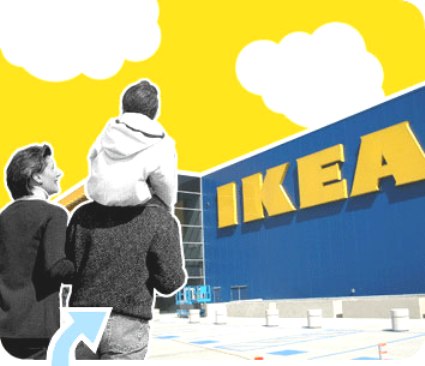 There are three words I often associate with the IKEA brand: cheap, innovative & stylish. Every customer knows that these characteristics are deeply etched into IKEA’s product design and development philosophy. Only some customers know that these characteristics are communicated through IKEA’s digital offering – for example, last year, they launched the Facebook Showroom Campaign. In my opinion, advertising agency, Forsman & Bodenfors, have devised a world-class creative strategy for IKEA by leveraging the cost-free Facebook platform, specifically, the photo tagging and comments functionality, to create mass brand buzz. As a corollary, IKEA is now positioned as being more mature in social media as well as a conversational, engaging brand.
There are three words I often associate with the IKEA brand: cheap, innovative & stylish. Every customer knows that these characteristics are deeply etched into IKEA’s product design and development philosophy. Only some customers know that these characteristics are communicated through IKEA’s digital offering – for example, last year, they launched the Facebook Showroom Campaign. In my opinion, advertising agency, Forsman & Bodenfors, have devised a world-class creative strategy for IKEA by leveraging the cost-free Facebook platform, specifically, the photo tagging and comments functionality, to create mass brand buzz. As a corollary, IKEA is now positioned as being more mature in social media as well as a conversational, engaging brand.
However, social media is only one piece of the digital channel puzzle. Another piece is online retail, or e-commerce, and to date it’s still missing. There are reasons why an online retail channel hasn’t been pursued just yet– all unknown to me. Perhaps it’s that their current distribution model can’t handle a multi-channel offering without significant process re-engineering. Perhaps it’s that they don’t have any serious competitors in the online market. Or perhaps their research shows that customers don’t need it (which I highly doubt). Either way, I believe e-commerce should be part of IKEA’s digital strategy and should be the next big offering from IKEA.
Here are some reasons why:
1. The current in-store customer experience is painful
I’ve commonly heard that the in-store experience quickly degrades from being fun and exciting to long and boring. Why? Because of the physical store layout, which is uni-directional. All customers are funnelled down one path and have to pass through all showrooms before they can exit. The path to cross-sell/ up-sell couldn't be any more obvious, let alone anymore painful. An e-commerce solution would assist in diluting this negative customer experience by offering customers with a new channel (that’s flexible and multi-directional) that they can peruse around. Cross-selling/up-selling would also be present, but subtly displayed to the user as recommendations.
2. The digital channel empowers the customer
One characteristic the digital space has over the in-store experience is the ability to tangibly model, in real time, your dream home or office. In the digital world, the customer is empowered. Everything is available at the tips of your fingertips...literally. IKEA provides a downloadable CAD 3D-modelling application (PC’s only – sorry Mac fans) which gives customers full expression to DIY. Install a cabinet...move a heavy shelf...that's just two clicks. Don't like it? Click. And it's all blown away. This highly immersive, visual, tangible and somewhat realistic experience cannot be provided to customers in the real world currently. Imagine being able to buy all of your furniture in a hassle-free, express checkout once you’ve modelled your dream home or office.
The only change I'd make to the downloadable 3D-modelling application is to remove it and replace it with a web application. This way, IKEA wouldn't be isolating the Apple-using market (which by consumer behaviour shares similar characteristics to IKEA customers - innovative & stylish). I would also consider other technologies, other than Flash, to develop this new web application (once again, so as not to isolate the Apple market). However, having said this, I do realise that the user experience should not be dictated by the technology stack.
3. IKEA shoppers are cult-like
IKEA shoppers love IKEA products. They love to talk about what they’ve purchased and recommend their favourite items to their friends. All you have to do is look at IKEAFANS.com [http://www.ikeafans.com/] There's a real cult following for IKEA products (not as disturbing as Apple, but still somewhat formidable). With an e-commerce capability, I would tap straight into this cult energy. Imagine being recommended a product by a friend on the IKEAFANs.com forum and being able to directly purchase that product within the forum itself. You’re improving customer experience by eliminating the hassle of having to travel to your closest store and then search in-store for that particular product.
4. The current digital customer touch points need to be interlinked
A quick scan of IKEA’s customer touch points in their digital channel indicates social media presence (Facebook, Twitter, YouTube), an online and downloadable product brochure, online accounts, personalised shopping lists as well as the downloadable CAD 3D-modelling application. Only some of these digital assets are interlinked. E-commerce can act as the common glue between these touch points, resembling a hub-and-spoke framework. For example, customer should be able to purchase a product they’ve found from the online product brochure. Likewise, traffic can be driven from a tweet to a particular product page.
With the Australian Online Retail market ramping up, let’s hope IKEA can get on board and offer customers with an e-commerce channel.
What do you think?
Want more IKEA?
- Mark Pollard’s - How IKEA games you: The Real Gruen Transfer
- Julian Cole’s - Do you know the name of this Facebook viral marketing method
